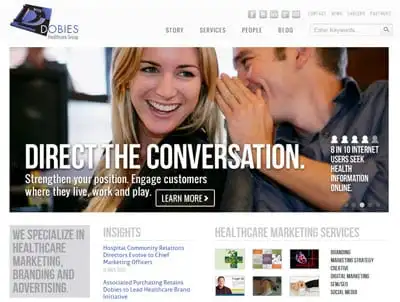So…what do you think of our new website? We hope you like it as much as we do, because if we don’t provide a helpful, informative and visually appealing experience while you’re here, then we’re just wasting space, plain and simple.
This is especially true for hospital and physician practice websites. These sites should be current, easily accessible resources for the eight in 10 internet users who seek health information online, but generally speaking, they’re not. Studies show many of today’s provider websites are mediocre at best. Why? Because these patient-facing sites don’t offer much when it comes to patient-friendly, patient-focused information.
What they do tend to offer in abundance is hospital- or practice-centric ‘About Us’ content. While it’s okay to provide an overview of the organization as a local patient care provider, that’s really not why people visit the site, especially when it comes at the expense of information patients really need, like whether their insurance will be accepted, what forms they’ll need for a first-time visit, which floor the lab is on, whether they can get a certain procedure at your facility, how to reach their specialist by phone, and so on.
Bottom line: the most successful healthcare websites put patients first. Why disappoint when you can ‘wow’ people instead? Making your site patient-friendly involves varying levels of complexity and expertise, but here are some things to consider that won’t require a complete overhaul:
- Be accessible to everyone. Offer concise content at a high school reading level – no long, jargon-heavy paragraphs. Make sure it’s a mobile-friendly site, because one in five cell phone owners in the U.S. today have used their phones to look up health-related information. Offer bilingual content if English is a second language for many of your patients, and accommodate people with disabilities like visual impairments that limit web accessibility if you can. Thanks to a wide variety of plugins, extensions and widgets available for today’s most commonly used content management systems, these tasks are often not as difficult as you might think.
- Make sure search engines can – and do – find you. Plugins for search engine optimization (SEO) are a dime a dozen these days. It helps to have key words and phrases in your content, but that alone is rarely enough to make you a top match in searches. Deploy SEO strategies to ensure people find you when your content answers the questions they’re asking.
- Keep it fresh. Stale, outdated content engages no one. Be sure to update your site with new developments relevant to patients, like upcoming health promotions, new doctors and services, extended appointment hours and so on. And if one or more of your physicians is willing to blog in layman’s terms on key medical topics and news, we say go for it!
By the way, online videos are also a great way to provide truly engaging content that users can access and absorb with ease. But that’s a whole other blog topic – read more here.
And finally, in terms of design, here’s your new mantra: No Clutter Allowed. Apply the same levels of neatness, logic and organization to your site as you do at your facility. Remember, your website is often your first chance to make a good impression, so use it wisely. Put the needs and interests of patients first.
SEO Companies
DesignRush.com
WebDesignCompanies.com
AppDeveloperListing.com
EcommerceCompanies.com

